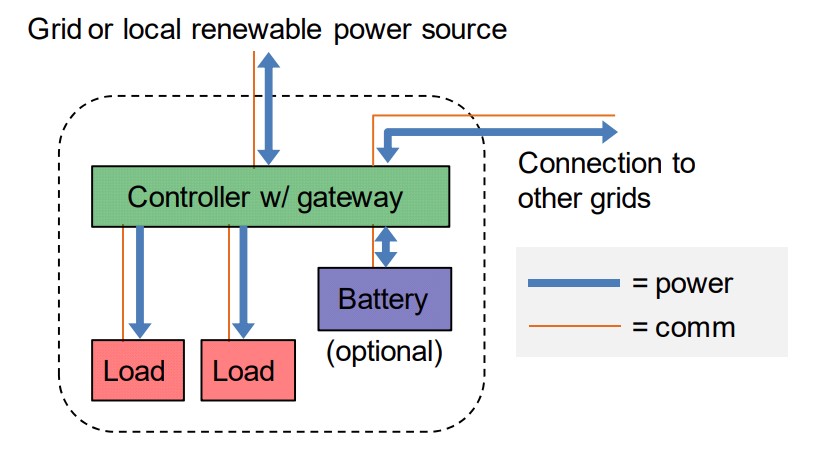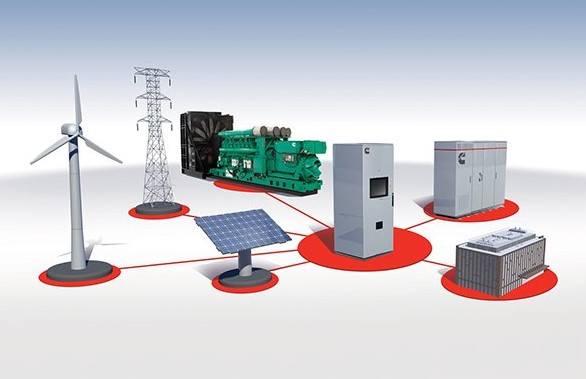Electric utility grids around the world are undergoing a fundamental change in architecture. The centralized grid that was designed to provide inexpensive electricity with a reasonable level of quality and reliability is no longer meeting society’s needs. Aging transmission and distribution systems are significantly reducing both the quality and reliability of electricity. And the use of traditional centralized power generation does not meet society’s environmental expectations for clean and green energy.
This FAQ series will look into some of the changes taking place in the electric utility grid architecture. It begins with the emergence of nano grids, microgrids, and the possibility of increasing the grid’s flexibility. Part two will look at the growing use of virtual power plants and distributed energy resources. Smart grid, the software-defined grid, and big data will be the focus of the third FAQ.
Matching supply and demand for electricity is a growing challenge. One of the architectural changes occurring in the electric grid is to accept a less reliable primary grid and push the maintenance of quality, sustainability, and reliability to the edge. In some areas, that challenge is being met using microgrids and nano grids.
Microgrids consist of groups of connected power sources and loads. Microgrids range in size from large commercial and industrial buildings to military bases or college campuses. A nano grid, on the other hand, is typically no larger than a single house. One of the ultimate goals of both nano grids and microgrids is to support zero net energy consumption and corresponding greenhouse gas reductions.
Nano grids and zero net energy consumption
The increasing installation of solar and storage in homes and other buildings drives the growth of nano grids. As a result of these trends, buildings can have multiple power sources, both AC and DC. Each source has different tradeoffs between availability and costs. Solar panels may have very low marginal costs of electricity, but they are generally intermittent. AC power from the local utility is more reliable but has a higher, and often variable, cost. Nano grids are designed to optimize these tradeoffs.

The emergence of nano grids is attracting startups with new solutions. One example is Amber Solutions, a startup focused on the development of a hyper-intelligent electrical architecture. With Amber’s recently announced devices, the Amber AC/DC Enabler™ and Amber AC Switch™, solid-state digital control of electricity is now possible in every device, appliance, power cord endpoint.
The AC/DC Enabler is a patented, UL-certified, and globally-compatible 30mm x 15mm x 8mm solid-state digital power management and control system, which, combined with the recently-patented Amber AC Switch, can deliver greater safety, reliability, and connected intelligence in all new and existing electrical infrastructure.
Amber’s innovation in solid-state technology is an advanced Digital Power Management and Control system (DPMC™) – a tiny solid-state device that efficiently runs power to highly sophisticated micro-controllers, processors, and RF devices directly from the AC main. It eliminates the need for bulky electromechanical components such as capacitors and magnetics that limit the reliability and functionality of devices today, effectively reducing the component count by a factor of 2.5. Eventually, Amber will put all of these components on a single silicon chip.
While companies such as Amber Solutions are focused on developing intelligent electrical architectures, the EMerge Alliance is focused on power distribution within nano grids. EMerge is an open industry association established to promote the adoption of safe, pure DC and hybrid AC/DC nano grid and microgrid systems.
EMerge Alliance develops and maintains open standards that integrate renewable and non-renewable power sources, wiring infrastructures, controls, and a wide variety of loads, from lighting, appliances, desktop, and plug loads all the way up to the building and campus-level HVAC and other support equipment. EMerge supports a common platform that adds flexibility, resiliency, and sustainability to new and existing renovation projects.
EMerge standards include 24Vdc power distribution for nano grids and small microgrids and 380Vdc distribution for larger microgrids. The 380Vdc standard is designed to create an integrated, open platform for power, infrastructure, peripheral device, and control applications to facilitate the hybrid use of AC and DC power within data centers and telecom central offices.
The EMerge alliance also supports the design and construction of zero net energy (ZNE) buildings. A ZNE building is a building that generates as much energy from renewable sources as it consumes. The use of DC power distribution and a nano grid can improve the overall building energy efficiency to support ZNE designs.

The Pika Energy Island™ from the Pika Energy division of Generac is designed for connecting energy sources, loads, and the grid, using a single islanding inverter in a nano grid architecture. Using its 380Vdc REbus technology, Pika Energy Island can deliver power, control, and communications all on the same wire. The connection of high voltage lithium-ion batteries requires no separate storage interface. The nano grid can power critical loads (120/240Vac) in islanding mode using an internal transfer switch. Unlike other systems, the Pika Energy Island does not require an external autotransformer for islanding.
The Pika Islanding Inverter is the hub of the Pika Energy Island, designed for backup power, self-consumption, and energy arbitrage. Pika PV Link is a sub-array solar optimizer and maximum power point tracker that connects PV arrays to Pika inverters, battery charge controllers, and other 380Vdc devices – designed for DC nano grids. It can connect to 2 to 9 modules for flexible array design. Pika PV Link is simple to wire and Rapid Shutdown-compliant (NEC 690.12).
Microgrids can be “free”
A complete microgrid solution intelligently coordinates various onsite, distributed energy generation assets to optimize costs and power stability, including the option to ‘island’ from the utility grid to avoid exposure to outages or disturbances. When the cost of grid energy rises, the microgrid can increase the consumption of onsite renewable or stored energy. Stored energy can also be sold back to the grid when most economical. And consumption of renewable energy can be maximized to meet greenhouse gas emissions targets.

For example, Cummins Inc. recently launched its new PowerCommand® microgrid control product line to manage, coordinate, and optimize distributed energy resources (DER). The new microgrid control line offers a suite of PowerCommand® Digital Master Controls for a variety of applications. The PowerCommand product line by Cummins is comprised of a one-stop-shop suite of solutions that encompasses new hardware, software, and services covering all facets of customers’ acquisition, management, and servicing of microgrid controllers.
Energy-as-a-service (EaaS) is a financing model for microgrids that allows users to avoid upfront costs. Similar to a software-as-a-service model, with EaaS users to avoid capital expenditures and instead pay only for ongoing service. EaaS enables a service provider (either traditional energy service providers (ESPs) or new ones, such as information and communications technology (ICT) companies) to offer various energy-related services rather than only supplying electricity. ESPs can bundle energy advice, asset installation, financing, and energy management solutions to offer a suite of services to the end consumers.
For example, Schneider Electric and their strategic partner, the Carlyle Group, have joined forces to create AlphaStruxure, a venture that finances, builds, and maintains microgrids. For example, public and private fleets – from transit buses to last-mile delivery – are embracing electrification. However, EV fleets require extensive new infrastructure and capabilities. A turnkey EaaS approach can bring together advanced microgrids, optimized charging infrastructure, and even vehicle financing, eliminating the need for up-front investment capital.
With their need for large amounts of continuous, clean, and affordable power, data centers are excellent candidates to benefit from microgrids. Microgrid technology has reached a high level of maturity, being adopted in many types of facility and infrastructure applications, such as utilities, community services, government offices, military bases, large industrials, hospitals, and educational campuses. EaaS is being used by a variety of organizations to decarbonize and achieve carbon neutrality.
Flexible local energy
Centrica recently completed the Cornwall Local Energy Market (LEM), the UK’s largest trial of energy flexibility, which saw over 200 homes and businesses trading stored renewable electricity. Electric vehicles, smart hot water tanks, and battery storage are key to unlocking the UK’s wind power ambitions by enabling home and business owners to trade electricity providing balance to the electricity grid, according to a report by Centrica.

Such inter-trading of electricity is known as flexibility, and the energy company has concluded the UK’s biggest trial of its potential in over 200 homes and businesses in Cornwall. Over three years, the £16.7 million Cornwall Local Energy Market saw 310MWh of power traded successfully, with greenhouse gas savings of nearly 10,000 tons a year as a result. Moving toward zero net energy consumption is also a goal of this project.
As part of the trial, five megawatts of low carbon technology was installed across more than 100 businesses, and a further 100 homes received a combination of solar panels and wall-mounted battery storage. The stored capacity of the home battery systems was combined to form a Virtual Power Plant and, when aggregated, was able to trade with the grid operators completely autonomously. Some businesses saved as much as 35% on energy costs by operating at times more aligned with grid needs.
Centrica’s LEM platform allows buyers to place bids for flexibility services, which are then matched with offers by sellers (homes and businesses) through auctions that run from months ahead of all the way to the same day. The platform manages the process for both sides, from contract creation all the way to baselining and settlement, making it easy to trade flexibility.
Nano grids and microgrids are being increasingly used to decarbonize energy generation and consumption, reduce greenhouse gas emissions, and move toward zero net energy consumption. As in the case of the Cornwall Local Energy Market above, microgrids can be combined with Virtual Power Plants (VPPs) to increase overall efficiencies further. The next FAQ in this series will consider “Virtual power plants, distributed energy resources, and power in the cloud”. It will begin by looking at the differences between a microgrid and a VPP.
Resources:
Digital control of electricity in modern solid-state architecture, Amber Solutions
Direct Current as an Integrating Platform for ZNE Buildings with EVs and Storage, Laurence Berkeley National Lab
Energy as a Service, Innovation Landscape Brief, International Renewable Energy Agency
Local Power Distribution with Nanogrids, Laurence Berkeley National Lab and University of South Florida
The Rewire-NW project: delivering a Smart Local Energy System, Cornwall Insight







Leave a Reply